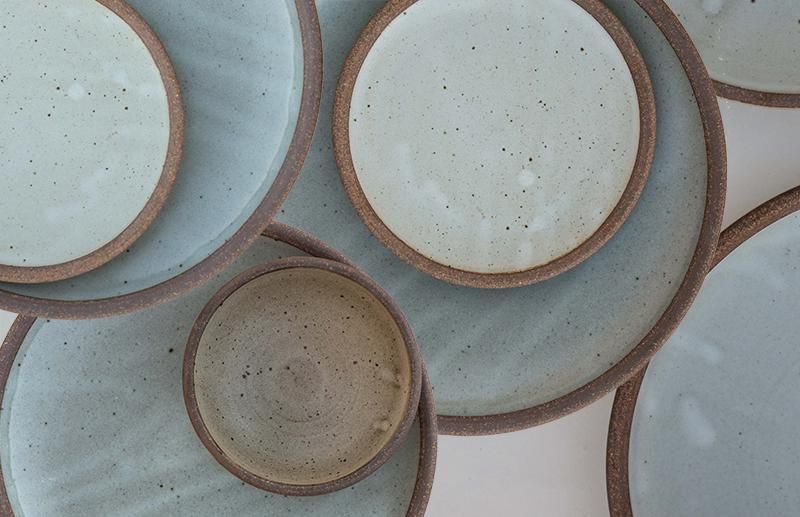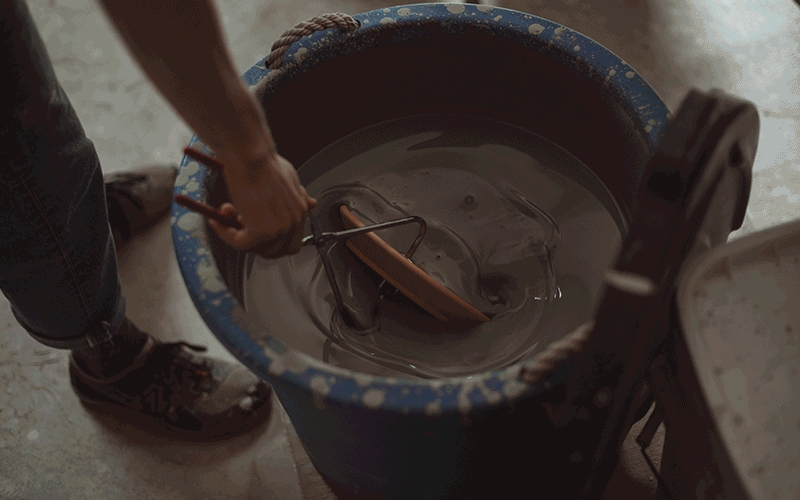
Let’s Get Technical
Forming: Thrown vs. Jiggered
 Formist Jeff Linton using our in-house made jigger press to make Shallow Soup and Salad Bowls. It's a very hands-on process.
Formist Jeff Linton using our in-house made jigger press to make Shallow Soup and Salad Bowls. It's a very hands-on process.
As many of you may already know, we’re deep in the slow, exciting, sometimes maddening process of transitioning our forming methods to include more mold-based and machine-integrated techniques. We’re so excited about these production changes not just because they’ll drastically cut lead times, but because they’re helping us make more consistent, stackable, useful forms. After sending a lot of bowls and plates out into the universe, we've learned that this is really what people are looking for.
All of our bowl forms will eventually be made using a jigger press rather than thrown on the wheel, we’re currently jiggering just four of our bowl forms: the Shallow Soup and Salad Bowl, the Medium Potter’s Bowl, the Large Potter’s Bowl, and - just this week - the Potter's Mixing Bowl.
We want you to know just what to expect from our new bowls, so we’ve shown our old hand thrown forms side by side with our new jigger pressed bowls. Below you’ll see that the old bowl forms still stack quite nicely with the new, but there are a few subtle changes to note.
Shallow Soup + Salad Bowls

Potter's Bowls
The main change you’ll notice in our jigger pressed Shallow Soup and Salad bowls is in the height of the foot - the new form has a shorter foot, allowing the bowl to sit closer to the table and with a slightly lower, wider silhouette.

Our jiggered Potter’s Bowls have a more fluid form, with a slightly lower profile and a more rounded base that simplify mixing and make it a bit easier to scoop that last bit of grub from the bottom of your bowl.
Glazing: Drips, Streaks + Specks

Since all of our work is glazed by hand with small-batch, house-made glazes, slight variations in surface should be expected and embraced. We find that small idiosyncrasies like streaking and speckling lend our dinnerware depth and character, but some people mistake them for flaws. Plenty of pots we make do have flaws - those end up on our seconds shelves - but slight variations in glaze appearance and texture are not only totally normal, but we think beautiful, too.
Streaks appear in some of our glaze surfaces as a result of our glaze application method: while many commercial potteries use industrial glaze sprayers, East Fork pots are dipped by hand into buckets of glaze, piece by piece. When a pot is dipped into and pulled out of a glaze bucket, gravity and small differences in viscosity from glaze formula to glaze formula (and batch to batch) can cause streaking. Some of our lighter, more neutral glazes - Morel, Eggshell, and Soapstone - have more flow and movement during application, causing a higher likelihood for subtle streaking.
The speckling that appears on the surface of some of our pots comes not from the glaze formulas, but from our minimally refined, iron-rich North Carolina clay body. We fire our pottery in a reduction atmosphere, which means we reduce the amount of oxygen present in the atmosphere of the kiln while it is firing. Because the gas searches for oxygen in order to burn and because the iron molecules in East Fork’s clay body contain oxygen, the gas in the kiln pulls specks of iron from the clay and up to the surface of the glaze in a random assortment of speckles. Firing in reduction is uncommon for industry potteries, but we think it is essential in highlighting the natural beauty of the North Carolina clay we use. We won't have it any other way.
 Cade, Kyle and Dan glazing plates in five gallon buckets.
Cade, Kyle and Dan glazing plates in five gallon buckets.
We are fascinated by the less easily controlled variables of our production methods and think the results are lovely, but we always encourage you to get in touch if you foresee any concerns when placing your order so we can make sure you're just as happy using your East Fork pots as we were making them.
